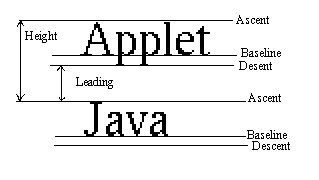简介
有些时候,文字过长,或者有多条需要展示的文本时,我们需要将文本进行左右滚动,多条文本时,还得上下滚动以实现展示不同的文本内容。这时候就需要我们自定义view来实现文本跑马灯效果了。
效果图
jjj.gif
Android文本参数 - FontMetrics
当我们要自己绘制文本的时候,怎么去计算文字的宽高,有些时候将本文的绘制起点设置为文本控件的中心点,却发现绘制的文本并不是居中的,下面讲解Android中文本是怎么样确定文本的绘制起点的。
基准点是baseline
Ascent是baseline之上至字符最高处的距离
Descent是baseline之下至字符最低处的距离
Leading文档说的很含糊,其实是上一行字符的descent到下一行的ascent之间的距离
Top指的是指的是最高字符到baseline的值,即ascent的最大值
bottom指的是最下字符到baseline的值,即descent的最大值
详情图
204735397.png
简化版图
ll.gif
在Android中,文字的绘制都是从Baseline处开始的,Baseline往上至字符最高处的距离我们称之为ascent(上坡度),Baseline往下至字符最底处的距离我们称之为descent(下坡度),而leading(行间距)则表示上一行字符的descent到该行字符的ascent之间的距离,top和bottom文档描述地很模糊,其实这里我们可以借鉴一下TextView对文本的绘制,TextView在绘制文本的时候总会在文本的最外层留出一些内边距,为什么要这样做?因为TextView在绘制文本的时候考虑到了类似读音符号,可能大家很久没写过拼音了已经忘了什么叫读音符号了吧……下图中的A上面的符号就是一个拉丁文的类似读音符号的东西:
gg.png
文本居中绘制:
// 计算Baseline绘制的起点X轴坐标baseX = (int) (canvas.getWidth() / 2 - textPaint.measureText(TEXT) / 2);// 计算Baseline绘制的Y坐标baseY = (int) ((canvas.getHeight() / 2) - ((textPaint.descent() + textPaint.ascent()) / 2)); canvas.drawText(TEXT, baseX, baseY, textPaint);
思路
单条文本
private void doSingleLineText(Canvas canvas){
viewHeight = getMeasuredHeight() + 10;
viewWidth = getMeasuredWidth();
contentBound.set(0,0,0,0);
contentPaint.getTextBounds(singleText, 0, singleText.length(), contentBound);
xOffset = contentBound.width() - viewWidth;
Paint.FontMetrics fontMetrics = contentPaint.getFontMetrics(); int textHeight = (int) ((-fontMetrics.ascent - fontMetrics.descent) / 2);
yStartPos = viewHeight / 2 + maxContentHeight / 4 + textHeight / 4; if (!hasInited) {
hasInited = true;
currentX = 0;
xStartPos = currentX;
} if (xOffset > 0) {
xOffset += contentTextSize * 2; if (!isHorizontalRunning) {
isHorizontalRunning = true; if (Build.VERSION.SDK_INT >= Build.VERSION_CODES.HONEYCOMB) {
startHorizontalLoop();
}
}
}
canvas.drawText(singleText, currentX, yStartPos, contentPaint);
} private void startHorizontalLoop() {
ValueAnimator horizontalScrollAnimator; if (horizontalOriLeft) {
horizontalScrollAnimator = ValueAnimator.ofFloat(0, 1);
} else {
horizontalScrollAnimator = ValueAnimator.ofFloat(0, -1);
} if (horizontalScrollSpeed * xOffset / contentTextSize < 0) {
isHorizontalRunning = false; return;
}
horizontalScrollAnimator.setDuration(horizontalLoopSpeed * xOffset / contentTextSize);
horizontalScrollAnimator.setInterpolator(mLinearInterpolator);
horizontalScrollAnimator.start();
horizontalScrollAnimator.addUpdateListener(mHorizontalLoopUpdateListener);
horizontalScrollAnimator.addListener(mHorizontalLoopListenerAdapter);
}上面的逻辑其实很简单,可以自己查看,我这里随便说一下,Android文本相关的知识
多条文本
private void doMultiLineText(Canvas canvas){ if (currentIndex >= contentList.size()) {
currentIndex = 0;
}
viewHeight = getMeasuredHeight();
viewWidth = getMeasuredWidth();
String currentString = contentList.get(currentIndex); int nextIndex = currentIndex + 1; if (currentIndex + 1 >= contentList.size()) {
nextIndex = 0;
}
String nextString = contentList.get(nextIndex);
contentBound.set(0,0,0,0);
contentPaint.getTextBounds(currentString, 0, currentString.length(), contentBound);
xOffset = contentBound.width() - viewWidth;
Paint.FontMetrics fontMetrics = contentPaint.getFontMetrics(); int textHeight = (int) ((-fontMetrics.ascent - fontMetrics.descent) / 2);
yStartPos = viewHeight / 2 + maxContentHeight / 4 + textHeight / 4; if (!hasVerticalInited) {
hasVerticalInited = true;
currentY = yStartPos;
} if (xOffset > 0) { //另外加点留白.设留白两个字宽
xOffset += contentTextSize * 2; if (!isHorizontalRunning && !isVerticalRunning) {
isHorizontalRunning = true; if (Build.VERSION.SDK_INT >= Build.VERSION_CODES.HONEYCOMB) {
startHorizontalScroll();
}
currentX = 0;
}
} else { if (!isVerticalRunning) {
isVerticalRunning = true; if (Build.VERSION.SDK_INT >= Build.VERSION_CODES.HONEYCOMB) {
startVerticalInterval();
}
currentX = 0;
}
}
canvas.drawText(currentString, currentX, currentY, contentPaint);
canvas.drawText(nextString, 0, currentY + viewHeight, contentPaint);
}多条文本,其实是在单条文本的基础上,加了一个向上滚动的动画,当像左滚动结束后,开启向上滚动动画,同时,当前滚动动画的文本index加一,详细代码请查看源码,下面会给出完成的源码地址。
作者:奔跑的平头哥
链接:https://www.jianshu.com/p/2274c401dea9
共同学习,写下你的评论
评论加载中...
作者其他优质文章









